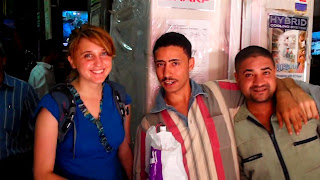When our countdown calendar to departure reached ten days, I was hit with strange combination of satisfaction and remorse.
The satisfaction is easier to explain. In our short time here, we have accomplished so much in the school that it is hard to fully realize the effect our work will have on the students and teachers. The crumbling walls have been transformed into solid structures that will sustain the building for a long time to come. The school has been brightened by paint and lighting, now matching illuminating ferocity with which the boys peruse their education. Ceilings fans have made the temperature in the school much more pleasant and facilitate the movement of air to carry away some smells from the bottles stored in back. A new sink has been installed with standard faucet, which is only too useful after sorting through some trash or making one of several pots of tea made in a day. Bathroom titles for the floors and walls made the bathroom more sufficient, hygienic and user friendly. A new door will soon be installed, providing the school with better safety and more functional use than the old wooden one it is set to replace. A projector has been purchased that will enhance the teaching tools available to staff. Computers are about to be purchased, whose usefulness for the school is invaluable. Combined, these things will make for a Recycling School that will truly meet the goals we set out in our project proposal, and leaving knowing that this has been accomplished fills me with the most sincere sense of satisfaction.
I struggled with the remorse I felt, wondering why having almost completed the project and being able to return home to family, friends, and the comfort American life would cause me grief. After some meditation on the discomfort that plagues me, I came to the following realization: in spite of having changed so much for the school, as I look around Egypt, I see so much more need. And, much to my surprise, the need is only partially for the community of Mokattam. Of course they have some negative correlations with lower incomes, like few hospitals and smaller apartments. But the need I see if for the world to know their story.

This realization came on the top of a hill overlooking all of Cairo. Like any city in the world, you see layers of buildings and streets, all of which you know are filled with constant commotion. However, here from this view, there was something different. In the picture, you can see so poignantly the same white mass of pollution that seems to haunt over the city. And this is what makes me sure that there is a need in Egypt for the Recycling School’s story to be told. The people we have been working with play an important role in the environment, recycling 80% of what they collect of the 13,000 tons of waste here everyday. This role they take with pride, contentment. However, their job is seen entirely differently by the rest of Egypt, and for the matter, much of the world.
The government of Egypt, according to the teachers at the school, wants to force them out of Mokattam. This may seem unrealistic, but considering the Egyptian Government contracted away their work to multinational corporations and forced the slaughter of their pigs, a necessary part of their waste management system, this true seems less than fictitious. And far from the government problems, the story of the zabbaleen is unknown by most locals, and if they did know, Egyptians seem not to care.
On a global scale, our project mentor Dr. Laila Iskandar notes, people see the plight of the zabbaleen and want to find ways to get the people out of this community. Instead of understanding the people’s determination to stay and continue their lives work, they see only their poverty and helplessness. This misunderstanding of the zabbaleen on a global scale needs to be corrected to show the world that in places across the globe, there are people who are dedicated to protecting the environment at lengths far greater than leaving then turning the lights off when you leave the house or recycling in your home.
I hope that over time, my remorse will subside into action, not apathy. I hope that at home, I do not forget the lessons I have learned here, and that I do not let compliance with “good enough” get the best of me.
--Casey








